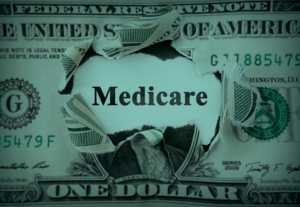The Affordable Care Act (ACA) extended health insurance coverage to approximately twenty million people, but more than twenty-seven million Americans still have no health insurance protection. Those who receive their health insurance through private sources still see healthcare inflation that is outpacing growth in GDP and growth in wages. Those in Washington, DC, who want to fix the ACA need to answer this key question: Is there a way to cover more people for less money and to lower the cost for everyone? An answer of yes to this question would mean we fixed the ACA. So, what are the proposals to do it?
Democratic Proposals
Republicans are on their heels after their repeal-and-replace failures. The debate regarding healthcare options will be driven by Democratic candidates. While Progressive Democrats support Medicare for all, the more moderate Democrat proposals include less-disruptive solutions that attempt to better connect public and private insurance programs to help fix the ACA’s ills. The main variances in the proposals relate to the program platform and eligibility.
- Platform—Medicare, Medicaid, or a new public-plan option could create additional choice and competition in health insurance. Some proposals create a new federal program that would compete with private insurance. The new public option would be available through the Marketplace. Other options skip the creation of a new program and simply allow people to enroll in the existing Medicare or Medicaid programs.
- Eligibility—Public programs could be available to anyone as an alternative to private insurance. Eligibility could be limited to only those who are not eligible for employer-sponsored coverage. Eligibility could have an age or income threshold. The range of eligibility options is broad.
- Age-Based Buy-In—One option is to allow individuals to buy in to Medicare at an earlier age, like fifty or fifty-five. This approach could provide a lower-cost option for those who are at the most expensive levels of the individual health insurance rate table. The irony of lowering Medicare’s eligibility age is that Social Security eligibility has already been raised to age sixty-seven from age sixty-five in order to lower the government’s cost of the program. The CBO has provided Congress with a cost estimate of increasing Medicare eligibility to age sixty-seven to align with Social Security. The Social Security change and the CBO cost estimates conflict with the age-based Medicare buy-in concept.
- Marketplace Option—This approach would put the Medicare, Medicaid, or public option on the Marketplace for individual health insurance only. Individuals eligible for affordable employer-sponsored health insurance coverage would not be eligible for a subsidized public-plan option. Limiting the public option to only the individual marketplace would be a more palatable solution for pharmaceutical and hospital lobby groups because it would keep the more lucrative private insurance reimbursement in place for employer-sponsored health plans. This approach could result in further cost shifting making employer-sponsored insurance even more expensive.
- Marketplace Plus Small-Employer Option—The offer rate of health insurance for small employers is much lower than for large employers. One option is to open the public plan to small employers to encourage more employment-based health insurance coverage through a lower-cost public option.
- Medicare for All Who Want It—At least one Democratic proposal would open a newly developed Medicare program—Medicare Part E—as an option for all employers to offer for their employer-sponsored health plan. Most other proposals keep large employers out of the public-plan option.
Americans are not highly satisfied with the current state of healthcare options. Politicians are busy crafting potential new health insurance options to woo voters.
Public-Plan Option
The original House and Senate bills that ultimately led to the ACA included the creation of a public-plan option that would have been offered on the Exchange alongside the insurance company plan options. The public plan would have been government-run and would have based its reimbursements to providers on Medicare payment structures. One approach proposed paying medical providers the Medicare rate plus 5%, and the other proposed paying Medicare plus 10%. This reimbursement level is far less than what the private insurance market pays.
In the end, these public-plan options were negotiated out of the final ACA legislation. Resistance to the public-plan option came from both hospital and insurance-company interest groups. It would have been difficult for private insurance companies to compete with a plan that paid medical providers substantially less for medical services. The insurance industry would either be eliminated by the lower-cost public-plan competition or demand significantly lower rates that are closer to the public-plan levels from medical providers. Under either competitive scenario, I believe a public-plan option would have lowered the cost of health insurance because it would have reduced the amount paid to medical providers.
Instead of a public-plan option, the ACA created co-ops to compete with private insurance. The co-ops were not-for-profit insurance entities created with federal subsidies to try to create competition for insurance companies and choice for consumers. Nineteen of the twenty-three co-ops created have failed and are no longer operating. (1) There are a host of reasons for the failures, but the bottom line is that most underpriced the health insurance risk and were relying on government subsidies for financial sustainability.
I was giving a speech in Wisconsin soon after the first co-ops failed. I explained to the group how the government-created and -subsidized co-ops were intentionally underpricing health insurance to gain market share and that the government’s unwillingness to provide unlimited funds was causing failures. A gentleman in the back of the room stood up and let me know he was an actuary who had worked for several of the now-failing co-ops. He explained that the co-ops had been founded to create competition and had not been intended to make money or break even. His view was that the government broke its promise by limiting its financial subsidies to cover the co-op losses. My view was that taxpayer money was squandered by a bad idea. Health insurance is expensive because healthcare is expensive, and the co-ops did nothing to lower the cost of care; they simply used taxpayer money to underprice their competition.
The failure of the ACA-created co-op program decreases my confidence in the government’s ability to create a new program to compete with private insurance. Price manipulation and government-subsidy reliance are not effective building blocks for a sustainable, successful business. Therefore, the utilization of either Medicare or Medicaid as a public-plan option, rather than the creation of a new entity or program, inspires greater confidence.
Medicaid Light
What if the Health Insurance Marketplace, formerly called the Exchange, had been called Medicaid Light? It might have been a more appropriate moniker. Medicaid is the taxpayer-funded health insurance program for low-income participants. The Marketplace is the predominantly taxpayer-funded health insurance program for individuals who make up to 400% of the FPL and do not have access to affordable health insurance through an employer. The average annual Marketplace subsidy per enrollee increased to $6,696 in 2018 from $3,108 in 2014. (2) The average subsidy is 86% of the total premium. (3) With this percentage of taxpayer funding, it is fair to categorize the subsidized Marketplace as a public program. Is it an efficient use of taxpayer dollars to reimburse providers at private insurance network reimbursement rates for a publicly funded program?
How would Medicaid Light differ from the Marketplace that was created or from a public-plan option that was considered? Medicaid Light could use the Medicaid administration-and-reimbursement platform. Medicaid has experienced the lowest rate of inflation among health-plan types over the past decade, while the individual insurance market has experienced the highest rate of inflation. (4) Medicaid reimburses medical providers far less than private insurance does. I believe Medicaid Light would have produced a financially and administratively less burdensome approach to subsidized health insurance.
Medicaid Light could also be a platform for a public-plan option. If the federal government, or even a state government, decides that a public plan needs to be offered as competition for private insurance in the Marketplace, Medicaid is an existing program that could be offered. Utilizing existing Medicaid for a public-plan option, rather than creating a new program, would increase speed to market and decrease administrative costs.
Calling the Obamacare Marketplace “Medicaid Light” would have significant public-perception challenges. People want an “Advanceable Premium Tax Credit” (the official name of the healthcare subsidy) to lower their cost of healthcare premiums. The Medicaid Light naming would not change the subsidy system, but it potentially carries the sense of being a government handout if “Medicaid” is in the name. The subsidy could be interpreted as a premium offset if used to purchase private insurance through the Marketplace, or the same subsidy could be viewed as a government handout if referred to as Medicaid Light. On average, Medicare participants pay approximately 14% of the total premium. This is almost identical to the percentage of premium paid on average within the subsidized Marketplace. I don’t believe people consider Medicare a “government handout,” but I sense that leveraging the Medicaid platform and naming could be viewed negatively by subsidized participants. The name matters!
Medicare for More
Multiple Democratic proposals include expanded Medicare eligibility. Mayor Pete Buttigieg refers to his approach as Medicare for All Who Want It. I call it Medicare for more. Unlike Medicare for all, Medicare for more would use the existing Medicare program but would expand eligibility.
The Medicare for more options surround eligibility and cost. The first question about Medicare expansion is who would be newly eligible. Some proposals lower the Medicare eligibility to age fifty-five, and others would make all ages eligible. Some proposals would provide Medicare as an option only for individual Marketplace participants; others would include small employers; and some would open Medicare as an option for all individuals and groups.
The second question is how much they would pay. Existing Medicare premium rates are indexed based on income but do not have any age variance. As previously mentioned, taxpayers fund approximately 86% of the cost of Medicare, and participants pay about 14% on average. How would Medicare funding rates be set for newly eligible populations, and how much of the premium would they pay?
The Case for Medicare for More
Medicare is a popular and effective public-private partnership. The cost for Medicare would be lower than the cost of private health insurance because Medicare pays medical providers less than private insurance does. Expanding the existing Medicare program is infinitely easier than creating a new program. It lowers cost and is easy to implement . . . what’s not to love?
The Argument Against Medicare for More
Expanding Medicare eligibility seems like a low-risk, easy fix to some of the current Marketplace problems. Medicare has one potential financial hurdle, however: The Medicare Hospital Insurance trust fund is on a path to insolvency by 2026 because expenses are projected to be larger than revenues in Medicare each year until then. Any expansion of Medicare would need to enhance Medicare’s solvency through excess premiums and not further threaten its solvency. Expanding eligibility without fully funding the newly covered population could further jeopardize Medicare’s financial future. The federal government’s history of underfunding entitlement expansions gives me little confidence that Medicare for more would carry its own financial weight.
Medicare enrollment is growing even with no change in eligibility rules because of the aging demographic mix in America. Politicians are talking about potentially adding a substantial number of people into Medicare through their eligibility-expansion plans. The final chapter of the opening section of the 2019 Medicare Trustees report summarizes Medicare’s current financial position:
The financial projections in this report indicate a need for substantial changes to address Medicare’s financial challenges. The sooner solutions are enacted, the more flexible and gradual they can be. The early introduction of reforms increases the time available for affected individuals and organizations—including health care providers, beneficiaries, and taxpayers—to adjust their expectations and behavior. The Trustees recommend that Congress and the executive branch work closely together with a sense of urgency to address these challenges. (5)
Do you believe Congress and the executive branch are working closely together with a sense of urgency to address Medicare’s financial challenges? The campaign discussions involving Medicare fail to mention Medicare’s tenuous financial position. The Medicare Trustees are telling Congress and the president to get to work solving Medicare’s financial struggle and to do it now. They are telling healthcare providers, beneficiaries, and taxpayers to get ready for potentially significant changes. Benefits or eligibility might get limited, premiums might increase, payments to medical providers might drop, and taxes might need to increase. Status quo in Medicare financing is a financial dead-end road. Adding new groups of people into Medicare without honestly confronting the financial challenges is like moving people on to the coastline with an active hurricane warning. The Medicare Trustees are sounding the economic warning siren, but politicians are talking about inward migration rather than an evacuation plan.
Could Medicare expansion help solve the perilous financial outlook? Yes, if the revenue generated from the newly eligible populations is greater than the cost to provide the benefits—in other words, if the program is profitable. The federal government’s track record of responsibly funding entitlement programs is poor and contributes to our debt and annual deficit problems. Expanding the Medicare promise is a great way to get votes, but adequately funding Medicare’s rising cost is not.
Expect pharmaceutical and hospital industry groups to vehemently oppose Medicare expansion. Groups like the Partnership for America’s Health Care Future (PAHCF) are aligning stakeholders against expansion of public programs. Logos on the PAHCF website include America’s Health Insurance Plans, American Hospital Association, Blue Cross Blue Shield Association, National Association of Health Underwriters, PhRMA, and many others. What could possibly bring these traditional adversaries together? Medicare expansion means lost revenue for many stakeholders, and the loss of money can bring traditional adversaries together to fight a common enemy. Expect the ads from groups like PAHCF to send a message of lack of choice, lack of access, and lack of innovation in healthcare.
What’s Next?
A public-plan option is a logical compromise that sits between the status quo and Medicare for all. Expect moderate Democrats to embrace this approach as a way to fix Obamacare by expanding choice and lowering cost through new competition. The real question for moderate Democrats is which program and expanded to whom?
Next week, we’ll take a look at an all-payer system and what that means, along with Medicare indexing. And, if you haven’t already, I encourage you to sign up for the “Insiders’ Club” where you’ll be notified when I release new information on my book “The Voter’s Guide to Healthcare: A non-partisan, candid, and relevant look at politics and healthcare in America.”
And great news…the book is also now available for sale on Amazon and Barnes and Noble. Check it out if you’re interested.
Sources
- National Association of Insurance Commissioners. “Health Insurance Cooperative.” April 18, 2019.
- ASPE Research Brief. “2019 Health Plan Choice and Premiums in Healthcare.gov States.” Aspe.hhs.gov. October 26, 2018.
- Centers for Medicare and Medicaid Services. “Health Insurance Exchanges 2018 Open Enrollment Period Final Report.” Cms.gov. April 3, 2018.
- Centers for Medicare and Medicaid Services. “National Health Expenditure Data, National Health Expenditures by Type of Service and Source of Fund, CY 1960–2017.” Cms.gov. April 17, 2018.
- Centers for Medicare and Medicaid Services. “2019 Annual Report of the Boards of Trustees of the Federal Hospital Insurance and Federal Supplementary Medical Insurance Trust Funds.” Cms.gov. April 22, 2019.








